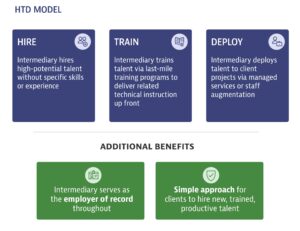Key Highlights
Challenges
With the advent of AI, entry-level job seekers without work experience face new barriers to obtaining — and holding — jobs with a living wage and a clear path for economic advancement. These career pathways are increasingly out of reach for workers without college degrees and sometimes even those with a degree.
Apprenticeships meaningfully raise candidates’ earning potential and save the government money, with one study finding that every $1 invested in apprenticeships saves taxpayers $7.80 over 10 years. Yet compared with many other industrialized nations, the American labor market has markedly fewer apprenticeship-style opportunities for early-career workers to earn while they learn.
Opportunities
Traditionally, few industries have established registered apprenticeship programs at scale, beyond their traditional domain in the building and construction trades. Many employers are now turning to a different earn-and-learn model led by organizations that implement a new, high-intervention model called Hire-Train-Deploy (HTD).
HTD programs resemble apprenticeships, as they offer entry-level jobs with on-the-job skill development, along with providing good wages and a promising career path. But unlike registered apprenticeships, HTD trainees are initially employed by a third-party intermediary organization that serves as their employer of record. Because the HTD intermediaries employ the workers, they are incentivized to offer additional training to teach skills that are not easily replaceable by AI.
In the HTD model, intermediaries recruit and hire inexperienced workers, train them in technical and professional skills while paying them wages, and deploy them to client projects to allow companies to “try before they buy” — so client companies can see the work of potential employees before committing to a permanent placement. Fees from clients cover both the intermediary’s services and the costs of compensating the participants. Unlike a traditional temporary staffing agency, the HTD intermediary plans for its clients to routinely hire the staff that the intermediary deploys to their worksites.

Key Takeaways
- Hire-Train-Deploy intermediaries have created a new form of apprenticeship, appealing to American companies that view formal registered apprenticeships as outside their core business. It makes good business sense for companies to partner with HTD intermediaries who are willing to do the heavy lifting until apprentices prove their ability to do the job.
- Participants in HTD programs earn higher than average salaries and gain opportunities for career advancement.



